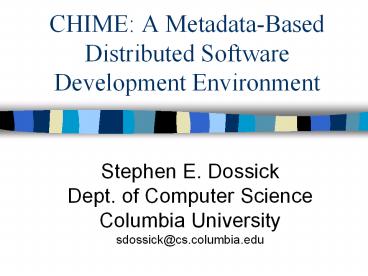CHIME: A Metadata-Based Distributed Software Development Environment - PowerPoint PPT Presentation
1 / 17
Title:
CHIME: A Metadata-Based Distributed Software Development Environment
Description:
CHIME: A Metadata-Based Distributed Software Development Environment Stephen E. Dossick Dept. of Computer Science Columbia University sdossick_at_cs.columbia.edu – PowerPoint PPT presentation
Number of Views:147
Avg rating:3.0/5.0
Title: CHIME: A Metadata-Based Distributed Software Development Environment
1
CHIME A Metadata-Based Distributed Software
Development Environment
- Stephen E. DossickDept. of Computer
ScienceColumbia Universitysdossick_at_cs.columbia.e
du
2
An Introduction
- Even small development efforts may involve
hundreds of artifacts - Design Docs, Change Requests, Test Plans, Code
Reviews, etc. - Sheer volume of data makes it difficult to find
what you are looking for, hard for new project
members to get started - Other research areas may offer us some hope
- 3D Information Visualization
- Hypermedia
3
CHIMEColumbia Hypermedia IMmersion Environment
- XML-based framework allows software artifacts to
reside in their original locations - Source Code in SCM system
- Design Docs in a Document Management System
- Email archives on Corporate Intranet
- Users interact with project artifacts (and each
other) by walking around a 3D Multi-User-Domain
environment - Novice users collaborate with experts who may
be in different physical locations
4
5
Conceptual Model
- Groupspaces
- Persistent collaborative virtual space in which
participants work - Project artifacts as well as tools used to
create, modify, and maintain them - Artifacts continue to reside in their original
repositories - SCM systems, legacy databases, rationale capture
systems, etc.
6
Conceptual Model (2)
- Groupviews
- Multiuser, scalable user interfaces used to
navigate and work in a Groupspace - Help users find and access relevant information
quickly - Keep users up to date on activities of other
participants - Virtual Environment rooms created from
artifacts residing in the Groupspace - Example Code module becomes a room, source files
become furnishings in the room. Corridors might
link a modules room to a room containing design
docs, etc. - Selective Awareness of other users actions
7
Conceptual Model (3)
- Software Immersion
- Virtual space defined by structure of artifacts
- Built semi-automatically from artifacts,
relationships - Architecture, organization of overall system can
be inhabited, virtually toured
8
Conceptual Model (4)
- Challenges
- Artifacts added, modified, deleted, moved in
underlying Groupspace - How to reflect this accurately in Groupview?
- Remote repositories for Groupspace data
- May not support transactions, locking
- May be temporarily unavailable
- Complexity of underlying software project
- How to design a Software Immersion which users
can understand?
9
CHIME Architecture
10
CHIME Architecture (2)
- Xanth Data Service
- Data organized into multi-rooted tree hierarchy
of XML dataElements - Each dataElement describes a single piece of data
residing in a remote repository - Xanth maintains an XML document which completely
describes the contents of the Groupspace
11
CHIME Architecture (3)
ltdataElementnameREADMEid1000protocolhtt
pserverlibrary.psl.cs.columbia.eduport80
path/linux-2.0.36/READMEhiddenfalseparent
0behaviorGET /gt
12
CHIME Architecture (4)
- Xanth Protocol Plugins
- Implement retrieval protocols needed to
communicate with data repositories - May provide behaviors to perform actions on the
data - E.g. for HTTP, behaviors are GET, POST, PUT
- Xanth Link Service
- Provides typed, n-ary, bi-directional hypertext
links among dataElements
13
CHIME Architecture (5)
- Virtual Environment Modeler (VEM)
- Parameterize each dataElement according to a set
of Virtual Environment Types - Base Types Component, Container, Connector
- VEM Types extensible for customization to
underlying data - VEM does not hardwire a user interface
- Provides only hints on how artifacts are related
14
CHIME Architecture (6)
- Theme Service
- Responsible for display, format, UI of Virtual
Environment inhabited by users - Theme Plugins
- Downloaded from server at runtime by clients
- Handle UI representation of Virtual Environment
for user 3D, text based, etc. - MUD Service
- Keep track of user locations, handle user
authentication, communications between users, etc.
15
Where do we go from here?
- How can we easily populate and manage a
Groupspace? - Versioning and Transaction support for Virtual
Environments - Personal Software Process Experiment
- Methodology Immersion?
16
Related Work
- MUD/MOO Systems
- Software Development Environments
- Groupware systems
- Software Visualization/Algorithm Animation
17
Conclusions
- CHIME Architecture flexible, scalable
- Linux 2.0.36 kernel source experiment
- Methodology Immersion likely to be as useful as
Software Immersion - Upcoming User Studies at Columbia and USC































